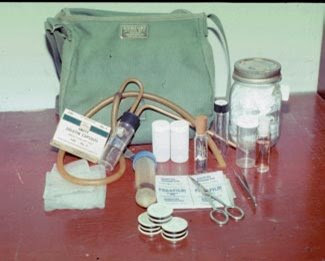
A field collecting kit.
The following items usually are included in the general collector’s bag:
(1) Forceps. Fine, lightweight forceps are recommended; if sharp-pointed forceps are used, care must be taken not to puncture specimens. If possible, grasp specimens with the part of the forceps slightly behind the points.
(2) Vials containing alcohol or other preservatives
(3) Killing bottles of various sizes.
(4) Small boxes or containers for storing specimens after their removal from killing bottles. These may be made of cardboard, plastic, or metal and should be partly
filled with soft tissue or cloth to keep specimens from rolling about. Do not use cotton because specimens become entangled in the fibers and may become virtually impossible to extricate without damage.
(5) Small envelopes for temporary storage of delicate specimens and/or gelcaps for tiny specimens.
(6) One or more aspirators .
(7) Absorbent tissue for use in killing bottles and aspirators.
(8) Notebook and writing equipment for jotting down notes and label data.
(9) A strong knife for opening galls, seed pods, twigs, etc and a pair of scissors for cutting labels.
(10) A small, fine brush (camel’s hair is best) for picking up minute specimens. Moisten the tip; tiny specimens will adhere to it and may be transferred to a killing bottle or vial.
(11) Bags for storing plant material, rearing material, or Berlese samples. For collecting much plant material, a botanist’s vasculum or tin box is advisable.
(12) A hand lens.




No comments:
Post a Comment